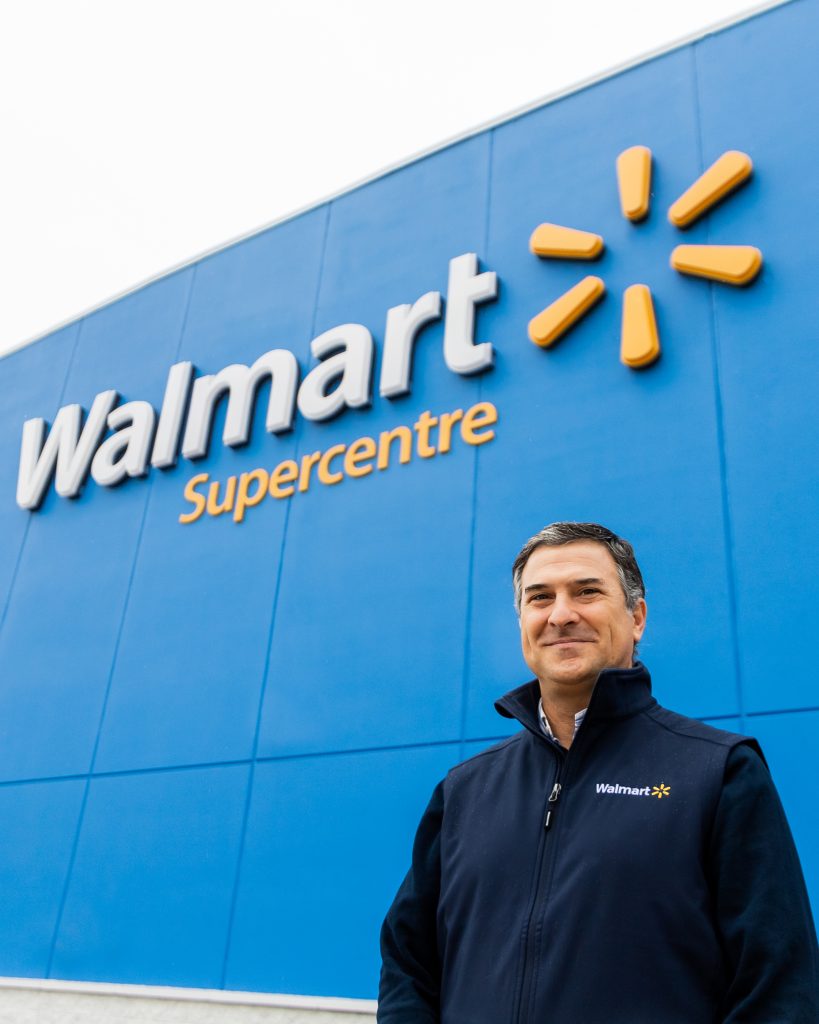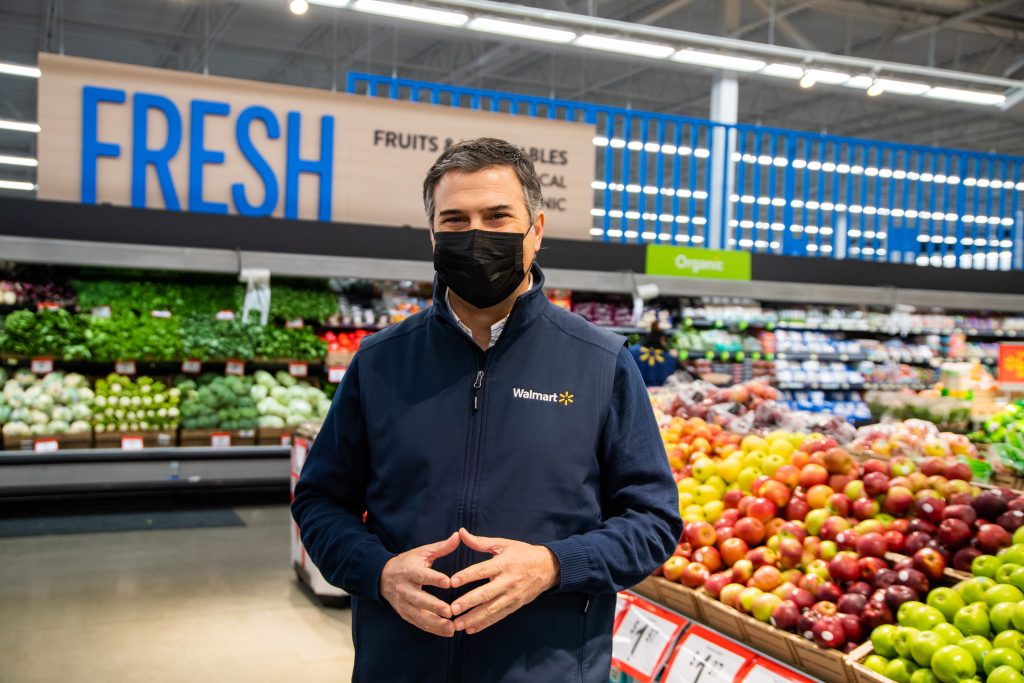
From strengthening its omnichannel capabilities to building a regenerative culture that yields benefits for people and the environment, Walmart is working hard to be the food retailer of choice for Canadians
When you’re the Canadian subsidiary of the largest retailer in the world, innovations tend to happen on a grand scale and with massive, meaningful impact – even when you’re confronted by a life-threatening pandemic.
Two years after COVID-19 hit the country, Walmart Canada continues to execute its strategies for business growth and for better corporate citizenship at larger-than-anything scales and brisk timelines. As part of a five-year, $3.5-billion plan, the company is expanding and upgrading distribution, modernizing more than one-third of its 400-plus stores, and integrating artificial intelligence, Internet of Things technology and an expanded blockchain platform into its logistics and supply chain infrastructure.
It’s doing all these in a retail market that’s markedly different from the one Horacio Barbeito, Walmart Canada’s president and CEO, stepped into when he moved to the country after leading Walmart in Argentina and Chile.
“The disruption from COVID created an at-home economy in Canada and in other parts of the world,” says Barbeito, who joined Walmart in 1995 as director of replenishment in Buenos Aires, Argentina. “And I think the trends of the at-home economy – with people working at home, studying from home and eating more at home – have become macro trends that are here to stay.”
These macro trends have, in two intense years, transformed how and where consumers purchase and receive their groceries. And like the at-home economy, these pandemic-influenced shopping habits are unlikely to revert to the old ways any time soon, says Barbeito.
“Customers are now channel-agnostic,” he says. “They’ve become omni customers – sometimes they’ll visit our store, sometimes they’ll order online and get their products delivered, or they’ll order online and pick it up. Or if they have an urgent need for something, they’ll order it online and get our last-milers to deliver it.”
Building for omnichannel
Walmart has moved nimbly – and boldly – to meet the needs of present and future omni customers. Three new state-of-the-art distribution centres are in the works in Ontario, New Brunswick and British Columbia. The largest of these, scheduled to open in 2024 in Vaughan just northwest of Toronto, will house next-generation automation and technology in a 550,000 sq. ft. space expected to handle more than 70 million cases of food products and general merchandise from over 3,000 suppliers – the highest volume of any Walmart facility in Canada.
At the same time, some Walmart stores across the country are being remodelled into hybrid locations featuring dedicated spaces where associates pick and pack online orders. These hybrid stores include product assortments that mirror the most-ordered items online, and on the floor, says Barbeito. “So our associates in hybrid stores with omni space can do more picks per hour and customers can have more open slots. This allows us to deliver or have their orders ready for pickup sooner.”
In 2020, the company expanded its omnichannel offerings by adding more than 20,000 grocery items to its Walmart Canada Marketplace, an “endless aisle” that lets customers shop from more than 175 third-party grocery sellers on the Walmart.ca e-commerce site. A year later, Marketplace grocery orders were six times more than the previous year, with a greater average order size.
Today, says Barbeito, about 29,000 Walmart associates work in omnichannel – representing the largest employee group in the organization and presenting concrete evidence of the huge and still-growing demand for this new model in retail.
“Customers want that mix of physical and digital, and that’s what we’re embracing”
Horacio Barbeito
“Customers want that mix of physical and digital, and that’s what we’re embracing,” says Barbeito. “A core part of our strategy today is to have a strong in-store proposition and a strong online proposition.”

Enhancing the online experience
Walmart Canada is clearly focused on creating the best customer experience, as evidenced by its omnichannel investments. As part of building a richer shopping environment online, Walmart Canada acquired Toronto digital start-up Foodmaestro in November 2020, with the intent of creating a more personalized e-commerce experience.
Foodmaestro’s digital platform turns data into usable attributes that can be personalized for customers, such as highlighting safe products for those with allergies or highlighting healthier options for people with diabetes. The system processes more than 14 million product attributes, 300,000 search requests and six million product validations in real time, each day. Foodmaestro also enables its clients to provide consumers with greater product transparency and trusted information-beyond the label, through SmartLabel.
Driving transformation with technology
Technology has been the great enabler of omnichannel retail. At Walmart, says Barbeito, artificial intelligence with machine learning capabilities ensures that customers and associates have direct line-of-sight into accurate real-time inventory at every location. Mobile tools that track orders and alert customers and associates to a delivery or pickup help to create a quick and seamless experience.
“If customers choose to pick up their order, they can use our mobile tool to notify us in advance that they’re coming to the store,” says Barbeito. “When they get to the store, they just park in one of our designated pickup parking spots and within five minutes, we’ll load their order.”
New order fulfillment technology is at the heart of a distribution centre in Cornwall, Ont. that opened in December 2021. The 40,000 sq ft space uses what Walmart describes as a “first-of-its-kind” technology for the company, which includes a “user-friendly” computer system with innovative logistics software to expedite orders to 136 stores from Kingston, Ont. to the East coast. The setup, which is part automated and part manned by employees, allows for 60,000 items to be shipped every 16 hours. Barbeito says the facility is part of a broader plan to modernize the company’s supply chain across the country.
Towards a regenerative company
Recognizing its ability to create deep, far-reaching impact through virtually anything and everything it does, Walmart has made a number of commitments recently towards greater environmental and social sustainability.
“We have one of the largest corporate commitments with Tesla for new trucks, with an order of 130 Tesla electric trucks to deliver merchandise throughout Canada,” notes Barbeito, “and we have set a goal of using 100 per cent alternative power for transportation by 2028.”
Walmart has also committed to stop giving out, by April of this year, single-use plastic shopping bags in store and for online order pickup and delivery. This translates to more than 680 million plastic bags eliminated each year.
“That’s equivalent to over four million patties, the largest commitment of any retailer in Canada,” says Barbeito. “We want our food to be healthy and affordable. We engage with companies that are committed to sustainable ways of farming and to environmentally friendly processes in many categories of fresh. Our private brand buyers are very focused on improvements in ingredients and formulations – it’s important for our customers.”

Last year, the company announced it would source 1.5 million pounds of beef from certified sustainable Canadian farms and ranches over the coming year.
These commitments are all part of Walmart Canada’s goal to become a “regenerative company” – one that goes beyond minimizing its footprint by working to generate benefits for the environment, its customers and employees, says Barbeito.
With the continued uncertainty brought on by the pandemic, Walmart is advancing a more comprehensive wellness agenda in the workplace, says Barbeito. In recent months, the company has organized programs and events focused on mental and physical wellness, and health equity. There’s also a greater focus on ensuring accident-free workplaces.
“Considering the volume of food that went through our distribution pipeline, especially in the last year, we know that our associates have been working very hard,” says Barbeito. “Their well-being is very important to us.”
Strong one-stop proposition
Whether customers come to Walmart Canada for grocery first or for general merchandise with a side-purchase of groceries, they value the one-stop shop at the company’s supercentres, says Barbeito.
“Our one-stop proposition has always been very strong, very solid,” he says. “And the pandemic reinforced that.”
Today, that one-stop shop has morphed into a mix of purchasing, delivery and pickup options. This is how Canadians want to buy their groceries, says Barbeito, and he hopes Walmart’s robust omnichannel strategy makes it the food retailer of choice for Canadians.
“We’re amazing at selling groceries and we’re very quickly becoming the preferred destination when it comes to fresh,” says Barbeito. “I’d like to see more Canadians give us the opportunity to serve them where they want, in the way they want.”
Walmart by the numbers
Retail on a grand scale
- 13 distribution centres in 2022
- 400+ stores across Canada
- 2,200+ Canadian suppliers
- 29,000 associates in omnichannel out of 100,000+ total associates
- 3 million daily shoppers instore and online
Building a regenerative company
- 100 per cent alternatively-powered fleet vehicles by 2028
- 130 Tesla trucks on order
- 1.5 million pounds of beef sourced from certified sustainable farmers and ranches this year
- More than 680 million plastic bags will be eliminated each year with the plastic bag ban


